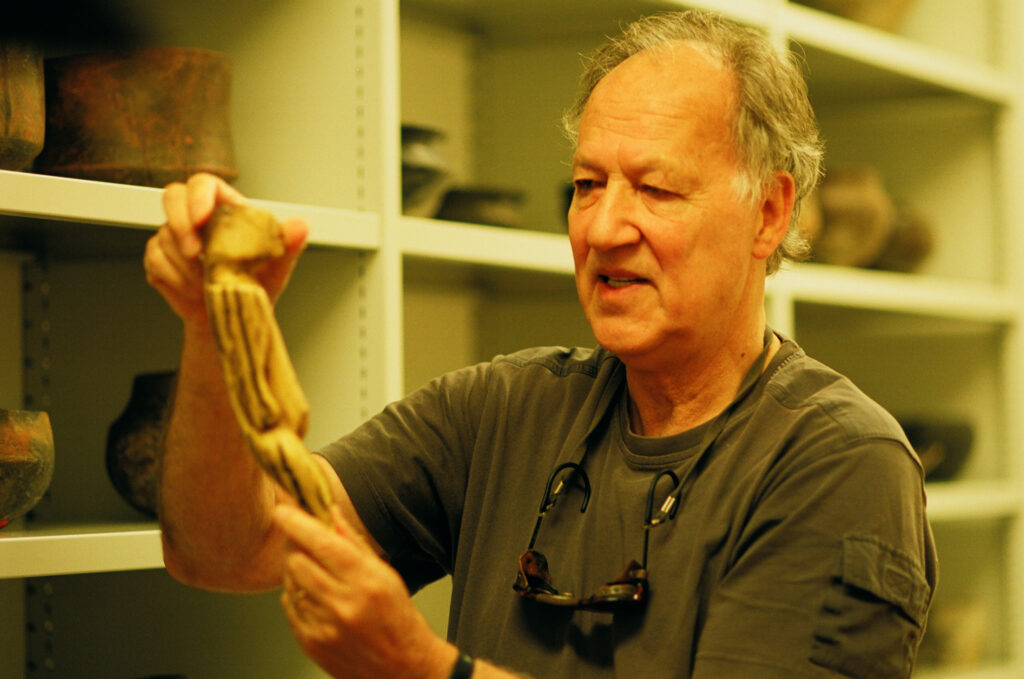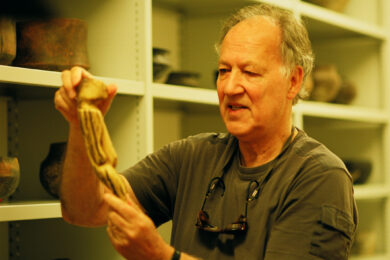If anyone was going to be capable of finding an artistic use for 3D technology in film, it was going to be Werner Herzog. His new film Cave of Forgotten Dreams is an intimate journey into the Chauvet Cave in the south of France. It contains an incredible collection of drawings and animal carcasses that date back some 35,000 years, and have survived thanks to a landslide millennia ago that sealed the cave off from the intrusion of visitors.
What makes the images so important is that they’re not seen as basic sketches, or primitive man’s ham-fisted attempts to depict the world in front of them. Instead, they’re the first evidence of expressive art in Europe. Images represent the movement of bison, horses and eagles that lived in that area, conveying how these early settlers saw the mannerisms and characteristics of these animals. Their purposeful use of the contours and curvature of the cave walls more than justify Herzog’s decision to shoot in 3D because, arguably for the first time, the film would be less persuasive without it.
As you’d expect, Herzog’s poetic and pondering narration aims beyond the images, using them rather as a mirror that reflects back onto those early people and creatures that used the cave over millennia. His ability to push the possibilities of engaging with people is accentuated, too, by his obsession with appealing to eccentric interviewees, such as the master perfumer who attempts to bring the scents of the age to life.
Across Herzog’s fictional films, we are always given a figure who, through their fresh or ‘uncultured’ eyes, make us see the world with all its pitfalls and absurdities. In The Enigma of Kaspar Hauser, a young man escapes from a lifetime of completely isolated imprisonment. Frightened and with no linguistic abilities, he is educated by interested locals in a small town and questions every one of their presuppositions with the inquisitiveness of a child. Similarly, Woyzeck is the simple sage who doesn’t pretend to understand the etiquette of the aristocrats, and Hias in Heart Of Glass is the quasi-Zarathustra character who takes a lofty perspective on the fickle town people. It’s no coincidence that in his documentaries Herzog’s observations are cast from a highly inquisitive perspective of his fictional heroes; there’s a palpable fascination with what makes people act the way they do.
In person, Werner Herzog’s excitable manner sits in an almost comical way along side his measured tone. Every sentence is uttered with the exact manner as his narration – rarely is the everyday more absorbing and the poignant so amusing and obvious. His voice has a semi-bewitching effect such that, after only the briefest of conversations, even simple tasks like walking down the road or buying a newspaper are carried out with the kindly spoken, philosophical German somehow controlling the vocal chords of your inner-monologue. Here’s what Werner had to tell The Quietus about his film, and the many abysses he sees across time and life.
What fascinated you most about the Chauvet Cave?
Werner Herzog: Well, it’s a combination of many things. There’s an extraordinary landscape: the gorge of the Ardèche river, which really looks like a romantic location and bridged by a natural arc of rock. In the commentary of the film, I say it almost looks like the set of a Wagner opera or painting by a romantic artist like Caspar David Friedrich. It appears as if romanticism was not the property of the romantics alone, it must have attracted people 35,000 years ago as well, because there is a whole cluster of caves around there, there is something that drew them into it. Of course that’s a lanscape, but when you look into the cave it’s like looking back into a deep, ancient echo of what we are today.
You mention Wagner. Do you see your work in opera and film as linked?
WH: Of course. Always. The grandest human feelings and emotions are in opera. You also see them in movies, and in a way you see them in the Chauvet Cave. When you look at Chauvet Cave, in one respect we are completely remote and yet we recognise something human about it. It’s the beginning of the modern human soul… the modern human culture, rather, to be more precise.
Let me say it in more primitive terms: the abysses of time are, in a way, unfathomable for us because we are somehow tied into history. We are a part of history, and apparently there, we’re not. And I give you this one example, of a charcoal reindeer, and someone else completed it 5,000 years later.
And their musical instruments…
WH: Yes, I used experimental archaeologists who reconstructed roots that were found in fragments – in this case, flutes made of the radius of a vulture bone. And they have found fragments of flutes carved in mammoth ivory, which is an extra sort of intelligence that put these fragments together, and what is the most stunning thing is that they’re tuned in pentatonic harmonies. It’s completely stunning. We do not know how they got it so accurate. When you look at a mammoth ivory flute that was made maybe 35,000 years ago, it is a high-tech procedure made with stone tools only.
Is it difficult trying to reconstruct such a remote age for a film?
WH: I just try to describe what fascinates me about this cave. There’s something extraordinary… the knowledge that this was made by people 35,000 years ago, it’s almost unfathomable. Of course, we know how the physical world looked for them; of course, much of Europe was under ice, the Alps were 3,000 metres under ice and you had rhinos and lions, and mammoths and bison roaming the south of France.
Where did you find the chap who was trying to sniff for caves?
WH: I was searching for someone who was exceptional. He was actually the president of the Master Perfumers in France, and I was intrigued to find someone because I learned that there were plans to build a complete replica of the cave – with all the formations, and bulges, and niches – and replicate the paintings. And there were even thoughts of replicating the odours. What might have been the odours of cave bears with smouldering fires, God knows.
I was deliberately searching for someone who could, from his extraordinary sense of smelling, describe what it could be. He has to fantasise, because all the odour has left some 30,000 years ago. But it’s another form of trying with your fantasy to explore what it could have been.
These eccentric characters are something of a fixture in your documentaries. What do they bring to a story?
WH: Men like the welder in Encounters At The End Of The World, who has these very oddly shaped fingers and who believes he’s from the royal house of the Aztecs and the Incas… you are immediately on his side. He has such an extraordinary warmth and charm and strangeness about him, and it takes 20 seconds and you are irrevocably on his side. And this is something which is very difficult in cinema.
Have you succeeded in recreating such characters in your fictional work?
WH: Only that I try. I don’t know that I accomplish it. Like this welder in Antarctica – he’s a figure who sticks in your mind forever, and you are on his side forever. It’s not just a person who is filmed from the outside. You are embraced by his warmth, by his soul, by his charm, by his oddness.
Do you go out of your way to find them, or do you attract them?
WH: [It’s] Not that I’m just looking for oddballs. But what you do if you are sent to Antarctica, and you know that five weeks later you have to return with a movie? What, for God’s sake, are you going to do in there? You just better keep your eyes open. They are usually very reasonable people… scientists and, amongst others, the caterpillar driver who has a PhD in comparative literature and a PhD in philosophy, and he says the most wonderful things… deep philosophical statements of great poetry.
A recurring character in your fiction is this outsider – whether they’re a simpleton or simply disillusioned – through whose eyes we’re forced to see the world. Do you find that narrating a documentary allows you a more direct way of similarly observing the world?
WH: I don’t think that I’m a simpleton. It’s legitimate that you say it, but my answer is that I’m a thinking man and I’m a keen observer. And I go wild in both fields: fiction and documentary. Otherwise, how would you explain a wild science fiction fantasy like the mutant albino crocodiles [featured in Cave of Forgotten Dreams]? But if you see one of my films, I give you the wildest science fiction fantasy whenever it comes at me. You couldn’t stop me by taking me out in a straight-jacket.
Would you say Death Row [his new television documentary] is a very different project from anything you’ve done before?
WH: I’m doing it with death row inmates in Florida… it’s not so dissimilar to what I’m doing in the cave. I’m really looking deep into an abyss, and you go to death row, you really look into human abysses. An abyss of a cave, an abyss of darkness, an abyss of time.
Do you ever take on a persona when you’re narrating?
WH: No, I’m only the storyteller. I do not emulate anyone in my films. I just feel a fascination that comes across. Of course, ultimately I’m a storyteller – I like to present the characters, and present them in the wildest stories and into your fantasies, and into poetry and into music. That’s the beauty of film making.
Surely you have to present yourself as a character?
WH: Not really, but of course people have a certain notion of me because they know my voice. What’s strange is that people really listen; they listen more than they would listen to a professional speaker. I don’t know why it is. I’ve been [getting] more and more into acting, and of course part of it is the voice.
Has the acting taken off recently?
WH: Two weeks ago, I had my apotheosis in American popular culture because I appeared in The Simpsons. It was released two weeks ago in the United States, but will probably reach other countries fairly soon.
How did that come about?
WH: Well, the makers of The Simpsons were drawn to my voice, and I’ve been the voice of one of the cartoon characters in Boondocks And I’ve been the voice in a very, very fine film by Ramin Bahrani called Plastic Bag, which has become a big sensation on the internet with hundreds of thousands of hits.
Have you seen the army of impersonators on the internet, like the Where’s Waldo video?
WH: No, I haven’t seen it. Of course, on the internet there are a lot of doppelgängers pretending to be me. There are six, seven, eight, ten or so doppelgängers out there, and I welcome them all. I welcome them all, as stupid as they may appear, as imperfect as they may appear, and as crazy as they may appear. I have the feeling these doppelgängers – these artificial clones – are almost like my bodyguards that surround me, and I feel protected behind them.
Do you ever slip into self-parody?
WH: There’s something like Incident In Loch Ness, where of course I’m poking fun at myself; there’s some self-irony, and this has been healthy…
Cave Of Forgotten Dreams is in cinemas now



